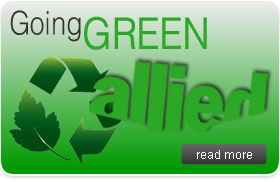Awards and Press
Finding the Right Port of Entry
Allied Printing Resources designs and modifies a web-to-print solution for the New York and New Jersey Port Authority.
By LaShell Stratton
The Port Authority of New York and New Jersey includes an immense network of bridges, tunnels, bus terminals, seaports and airports sprinkled as far south as the Outerbridge Crossing between New Jersey and Staten Island and as far north as the George Washington Bridge. Since 2001, Allied Printing Resources has served as a one-stop shop for all the Port Authority’s letterhead, envelopes and business cards, thanks to a customized web-to-print site powered by NowAllied.com.
“All of this was contractual,” says Jeffery Miller, vice president of sales at the Carlstadt, N.J.-based manufacturer that provides offset printing services. Miller says that the requirements of winning such a large contract were that the bidding company “had to give them a web-based solution and you had to be competitive.”
The contract with the Port Authority ran smoothly for several years, but in 2005 Port Authority officials came to Allied Printing Resources with a request that required the manufacturer to make modifications to its software to better fit the client’s needs. Miller says most of the request had to do with the Port Authority’s desire to simplify the print ordering process and have more oversight of print billing. The changes required Allied to modify log-in procedures for users but “this was fairly complicated because the code for this had not been written,” Miller says. The entire project would take roughly six months to complete.
The NowAllied.com sites allow for flexible billing options depending on the end user’s system. Some clients chose to bill by credit card; others, like the Port Authority, enter a cost-center code to track their billing. Prior to the changes made to Allied’s web-to-print software, the Port Authority had nearly 300 cost centers with unique log-in names and passwords. “They said it was all too hard to remember,” Miller says.
The Port Authority wanted to simplify the process with a central log-in that allowed one user to access all cost centers but still maintain the compliance measures of the older software version. “For each one of the cost centers there is a unique approver,” Miller says. “The approver receives an email that alerts them of the impending transaction and asks them to approve it or decline it. There are different compliance levels for different cost centers.”
The changes allowed the Port Authority to better monitor print orders placed by employees. “The trick is not just having people log-in, but tracking them through the system,” says Christopher Royer, Allied Printing Resources vice president of operations.
LaShell Stratton is assistant editor at Print Solutions magazine. Email her your comments at lstratton@PSDA.org.
Tips
• Steer end users down the road of least resistance. Although clients may seem to know what they want, don’t hesitate to give them advice about their web-to-print needs and what options may be best for them. You’ve been doing it longer and know the process.
• Be careful of offering too much customization (remember the bottom line). Every company is unique, says Jeffery Miller, vice president of sales at Allied Printing Resources. “As much as you try to generalize your site so that you offer the maximum amount of products and services, there will be a company that comes along that wants something different,” he says. “Everyone’s process is different. Some want compliance, some don’t. Some really don’t care. The trick is to try to solve all these companies’ nuances without overdoing customization and killing yourself financially.”
• Make sure everything is documented. Christopher Royer, Allied Printing Resources vice president of operations, advises companies that offer web-to-print capabilities to carefully document what services and products will be customized. Update the documentation as customer requirements shift and evolve. When the project is done, it should match your documentation on customer expectations about features and pricing.
The Back Story of NowAllied.com
Allied Envelope Company began in 1932 as a New York-area envelope printer. But Jeffery Miller, vice president of sales, says Allied Printing Resources, as it is now called, began developing its web-to-print technology in 1996. The first incarnation of NowAllied.com, called NowPrinting.com, was created with e-commerce solutions in mind. “We came on the stage back during the internet boom,” Miller says.
The New Jersey manufacturer partnered with a high-tech company to offer print solutions over the internet. “We wanted to build software that could enable us to sell printing to customers over the web,” he says.
Though Allied has one IT specialist on staff to help maintain the web-to-print sites, the company still outsources the rest of its web-related software and hardware needs to Corsis Technology, based in New York City. Corsis created NowAllied.com’s e-procurement system using Mac OS X, Java server pages, JAVA 2D, XML and Postgre SQL technologies. Corsis still writes much of the code for the sites and hosts Allied’s two servers.
But Chris Royer, vice president of operations, says though Allied may outsource its technical work, all of the orders over NowAllied.com are printed in-house. “We’re actually doing all of it ourselves,” said Royer says. “We have about 30 pieces of equipment on the floor.”
Over time, Allied’s web-to-print capabilities attracted a diverse client list, including the City of Philadelphia, Mass Mutual Financial Group, and the HMO Health Plus. “They all use it for different purposes. Some use it just for envelopes and others for inventory,” Miller says. Allied customizes the appearance of web pages for each client, “so that it’s like their intranet,” he says.


